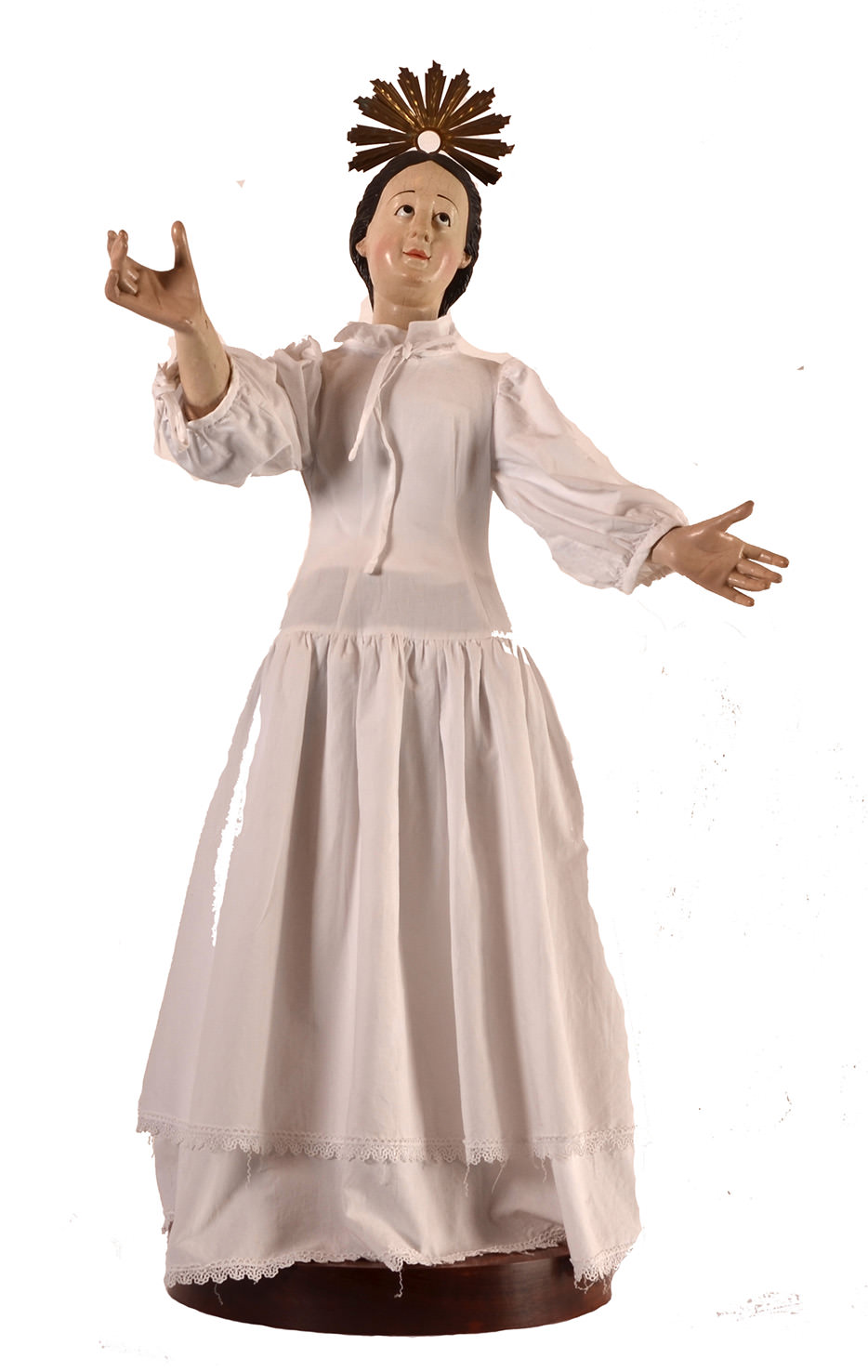a snippet of several existing types in addition to specimens that can still be seen in processions and altars in São Paulo
Museu de Arte Sacra de São Paulo – BUT/SP, institution of the Department of Culture and Economy of the State of São Paulo Creative, starts its exhibition schedule for the year 2021, in accordance with all protocols defined by the competent areas, with the show “Roca e de Vestir Pictures" with 37 works from the MAS / SP collection as well as from the Archdiocese of Sorocaba, Paróquia Nossa Senhora dos Remédios, Metropolitan Cathedral of São Paulo, Church of Nossa Senhora da Boa Morte and the Jack Luna collection. The curator is John Rossi and Beatriz Cruz.
Image of distaff is the name given to images, primarily sacred, conducted in procession and dressed in cloth garments. Unlike the pieces that existed in the churches and to lighten the burden, the images were only partially carved, with finishing only in the parts that should be seen by the public, like hands, head and feet, and the rest of the body consisted of a simple slatted structure or hollow frame covered by fabric clothing. In Brazil, this genre became important during the baroque period, especially in the 18th century, until the middle of the 19th century.
Differentiation between parts, beyond subtle, it is not watertight and is sometimes credited to interpretations. What should be emphasized is that the roca pictures true are those intended for participation in a procession, and those meant simply to be worn, the dressing pictures. “All images of rock are also to be worn, but not all images of dressing are from distaff ”, define a autora Maria Helena Ochi Flexor.
“Among the various sculptural forms that we find to represent the saints, there are so-called rock and dressing images, whose study, for a long time, was "despised" by the researchers for being considered as a minor artistic expression. Very popular in the 19th century, widely used in domestic worship and in processions, especially those of the Passion of Christ. During the 20th and 21st centuries, this type of representation gained notoriety and was reborn, also, as an object of desire for collectors ”, explains the curator John Rossi.
| Exhibition: “Roca e de Vestir Pictures” |
| Curated By: João Rossi and Beatriz Cruz |
| Opening: 23 January - Saturday - from 11am to 2pm |
| Period: from 24 January to 30 March 2021 |
| Local: Museu de Arte Sacra de São Paulo || MAS / SP |
| Address: Avenida Tiradentes, 676 -Light, São Paulo (Tiradentes station of subway) |
| Tel.: 11 3326-5393 - Additional Information |
| Timetables: From Tuesday to Sunday, from 10 às 17h (entry allowed until 4pm) |
| Entrance: R$ 6,00 (One piece) | R$ 3,00 (half national entry for students, private school teachers and I.D. Young – upon proof) | Free Saturdays | exemptions: children up to 7 years, adults from 60, public school teachers, disabled people, ICOM members, police and military – upon proof |
| TICKETS MUST BE ACQUIRED THROUGH THE MUSEUM WEBSITE – link to tickets |
| Number of works: 37 |
| Techniques: wood |
| Dimensions: varied |
Digital Media
WebSite: www.museuartesacra.org.br
Instagram: www.instagram.com/museuartesacra
Facebook: www.facebook.com/MuseuArteSacra
Twitter: twitter.com/MuseuArteSacra
YouTube: www.youtube.com/MuseuArteSacra
Google Arts & Culture: bit.ly/2C1d7gX
Press:
Press Office – Museu de Arte Sacra de São Paulo
Silvia Balady – (11) 3814-3382 | 99117.7324
silvia@balady.com.br || imprensa@museuartesacra.org.br
Sign up to receive Event News
and the Universe of Arts first!
Press office - State Secretariat for Culture and Creative Economy
Simone Blanes – 94003-1711 || Davi Franzon – 93411-6428 || Cíntia Ruiz - 98080-9800
imprensaculturasp@sp.gov.br
The Museum
The Museu de Arte Sacra de São Paulo, institution of the Department of Culture and Economy of the State of São Paulo Creative, It is one of the most important of its kind in the country. It is the result of an agreement signed between the State Government and Mitra Archdiocese of Sao Paulo, in 28 October 1969, and its installation date 29 June 1970. Since then, the Museu de Arte Sacra de São Paulo He came to occupy wing of the Monastery of Our Lady of the Immaculate Conception of Light, on Avenida Tiradentes, downtown São Paulo. The building is one of the most important monuments of colonial architecture São Paulo, built of rammed earth, rare remaining example in the city, last farm convent city. It was listed by the Historical and Artistic Heritage Institute National, in 1943, and the Council for the Defense of Heritage, Architectural artistic and the State of São Paulo, in 1979. It has much of its collection also listed by IPHAN, since 1969, whose priceless heritage includes relics of stories in Brazil and worldwide. The Museu de Arte Sacra de São Paulo holds a vast collection of works created between centuries 16 and 20, counting with rare specimens and significant. There are more than 10 thousand items in the collection. Has works of recognized names, as Frei Agostinho da Piedade, Frei Agostinho de Jesus, Antonio Francisco Lisboa, the "Aleijadinho" and Benedito Calixto de Jesus, Among many, anonymous or not. Noteworthy are also the collections of nativity scenes, silverware and jewelery, Lampadarios, furniture, altarpieces, altars, clothing, liturgical books and numismatic.
OF SACRED ART MUSEUM SAO PAULO - MAS / SP
Chairman of the Board of Directors – José Roberto Marcellino dos Santos
CEO – José Carlos Marcal de Barros
Director of Planning and Management – Luiz Henrique Neves Marcon
Museóloga - Beatriz Cruz


